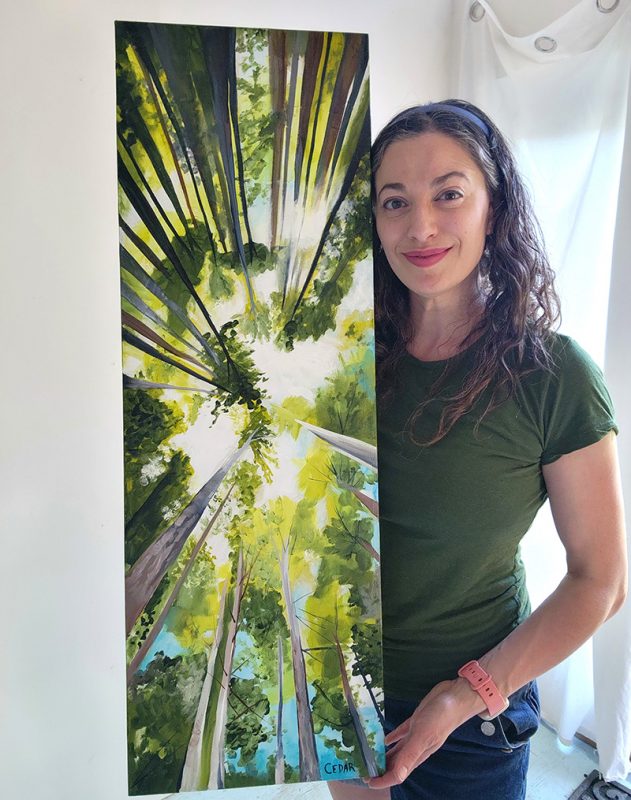 It’s true that not all art is expensive—you can find lovely handmade things for very cheap, for less than $100. It’s also true that some art is exorbitantly priced at hundreds of thousands of dollars and up—I am not referring to the Picassos and Rothkos that sell at auction. For now I’m just talking about contemporary art by living artists, like mine, that is priced in a reasonable mid-range—a few hundred to a few thousand dollars.
It’s true that not all art is expensive—you can find lovely handmade things for very cheap, for less than $100. It’s also true that some art is exorbitantly priced at hundreds of thousands of dollars and up—I am not referring to the Picassos and Rothkos that sell at auction. For now I’m just talking about contemporary art by living artists, like mine, that is priced in a reasonable mid-range—a few hundred to a few thousand dollars.
Suppose you see one of my paintings for sale for $1,890, and you think to yourself, “Good grief, that’s a lot of money. Why on earth does it cost so much?”
Well, you’ve got to think of it in terms of what goes into producing such a thing.
Here’s an approximate breakdown of that $1,890:
- Materials: canvas or hardwood panel, primer, paint and mediums, varnish, hanging hardware–people often don’t realize how expensive art supplies are. Depending on the color, one tube of oil paint can cost more than $40. I buy cold wax medium by the gallon, but even with the corresponding “bulk discount” for buying in large quantities, one can is around $100. Cheap art supplies are out there, sure, but my policy–thinking towards the future with archival quality in mind–is to buy the best materials I can afford. Materials:
$200
- Overhead: this unwieldy category includes the cost of rent or mortgage for studio space, utilities for the studio, tools, easel, computer, sketchbooks, camera, brushes, desk, chair, office supplies, file cabinets, shelving, phone, Internet, power tools and lumber to build shipping crates, work truck for transporting art and materials, car insurance, gas, entry fees for exhibitions, business licenses, taxes, etc., ad infinitum:
$250
Note: This number, obviously, can vary a lot. I calculate my overhead per painting by dividing the total costs for the year by the number of paintings I made that year. I am actually keeping my overhead extremely low by having a back yard art studio, using an old beater of a work truck for my deliveries to galleries and clients, refusing to work with “vanity galleries” that charge artists to exhibit, etc. An artist who is only able to produce a few pieces a year has extremely high overhead, while a prolific artist may be able to get their overhead relatively low. Professional artists all aim to be prolific, of course, but on the other hand, we are all limited by the laws of physics, time, and our own ability.
Note 2: Keep in mind: it’s uncommon for an artist to sell every piece created in a year. This means when an artist sits down to calculate their projected income, they must look at past trends to predict what percentage of their work will sell that year. Of course, the hope is that any unsold work will still be valuable inventory, assuming it sells in future years. I am one of the lucky ones in that close to everything I create does end up selling, but historically speaking, some of my pieces have taken a few years to find their buyers. As an artist moves up in his or her career and becomes more well-known, getting the work in front of interested buyers becomes less of a challenge. For an artist who is completely unknown, the challenge of getting their work in front of more eyes can be insurmountable. This is why the ones who succeed in the end are overwhelmingly the ones who make it their business to be savvy about marketing and/or social connections.
- Gallery commission: 40%-50%. Many people are shocked to learn that when an artist sells something in a gallery, the gallery takes up to a 50% cut of the sale, or more in some cases. This is an industry standard. It may sound unfair, but if a gallery is able to bring the artwork directly to buyers, in the end it is worth it because the artwork is actually being sold. While I sell my work through a combination of galleries and self-representation, I’d rather spend my time in the studio making artwork than trying to attract potential buyers. Less time on marketing means more art being created. Galleries have storefront property to maintain and plenty of their own overhead. Just like any other retail store, they mark up their products so that they can pay their expenses and make some profit. Gallery commissions vary, but they are usually somewhere around half of the artist’s retail price:
$940

You might think that if I’m selling a painting straight from my studio rather than in a gallery, the price would be much lower, right? Well, no. The price would be about the same. This is because I must keep my retail prices consistent to be fair to all the collectors of my work. You would not be happy if you bought a painting in a gallery and then realized someone else bought a comparable painting straight from the artist for half the cost!
So when somebody buys directly from me, I end up getting more of the money—and direct sales can be a windfall for an artist. This is where I get most of my actual profit from, which allows me to grow my business. I am so grateful for all the work I sell in galleries–it allows me to open up to new markets that would not be available to me otherwise. For me personally, relying on gallery sales alone would not be sufficiently lucrative. This varies from artist to artist depending on whether or not they’ve found galleries that can tap into a niche market for their work.
- The artist’s time—After I subtract the cost of materials and overhead from my cut of the sale ($940), this is what is left as payment for my time:
$500
Of course the time spent on a work of art varies greatly from artist to artist, and from piece to piece. The thing that most people don’t realize is how much time must be spent on things outside of the studio. This includes time spent planning, sketching, and brainstorming, researching, talking to clients, writing promotional materials, photographing and cataloging work, packaging and transporting work. Tack on the considerable time it took to actually make the painting.
Assuming I am very efficient, (I am) with all of these things accounted for, a painting may take me a total of 20 hours of work. While I work very quickly, another artist might take 100 hours or more to do a similar project. You are paying not only for my time, but also for my skilled labor—all the knowledge, experience, and intuition that is the culmination of years of study and work in my field.
Divide the retail price by the hours worked, and the buyer is paying about $95/hour once overhead is also figured into hourly rate. However, for this painting, I end up actually making only around $25/hour.
To put that in perspective, graphic designers charge $75-$150, a plumber often charges $100 just to show up and look at your leaky sink, and a good attorney may charge more than $300. So, a creator of an original oil painting selling in my price range ends up somewhere around the same as other creative professionals like graphic designers–the difference being that in many cases, the overhead of an oil painter is much higher and the take-home pay much lower.
You might end up wondering, “Why would anyone ever choose this career path?” That tells you something about the amount of love and passion artists bring to their work. Like any committed entrepreneur, we all start out with the expectation that we will be working many unpaid hours until we are established.
It comes down to this: Do you believe in paying people fairly for their time and expertise?
When you understand just how much goes into a piece of artwork, and how small the actual profit is, you will understand it from the artist’s point of view. The price will sound very reasonable—you will realize that you are getting a steal. Think about these things next time you see a painting or a sculpture that seems to be very expensive at first glance.
People should pay for the nice things that they want—buying art is like any other purchase of something that you want. It’s exactly like treating yourself to a new flat screen TV or the latest gadget, a beautiful sofa, a sexy couture jacket or a vacation. You wouldn’t raise an eyebrow about an $1,890 price tag on a large flat screen TV.
But here’s where scarcity comes in: TVs come and go. They are mass-produced and old models are replaced as new ones come out every few years. Meanwhile, the original handmade iteration of a work of art is the only one of its kind in existence. A piece of art, if well-made, will last hundreds or maybe thousands of years. It can be something beautiful that gives you joy or comfort every day when you look at it, something that you can pass on to your children after you are gone.
Art is timeless and unquestionably human—if you connect to a piece of art on a personal level, and you know it is something you want to live with every day, if you have the money, it is well worth paying for. Art collectors understand this, and the nature of art as a precious unique creation is the very reason you see famous pieces from art history being sold at auction for absurd prices. This dynamic only becomes possible when scarcity is so high. Luckily for the rest of us who are not millionaires, there are countless living, working artists selling their work right now at prices in the hundreds rather than the millions.

That said, you still may blanch at a large price tag and wonder to yourself, “Is this price negotiable?”
The answer is maybe. As long as you are not low-balling the artist with an insulting offer, it never hurts to ask. If somebody is buying multiple paintings, I’ll often give a discount of 5%-15%. If you’re buying, say, ten paintings to decorate your whole home, I may give you up to 20% off, free shipping on them all, an additional painting for free, or similarly huge perks. If you are a repeat collector, I know that you are the backbone of my livelihood, and I am very likely to give you exclusive deals to show my appreciation for your loyalty. I can’t speak for everyone, but I would bet most gallery owners and artists feel the same.
Many galleries and individual artists are also willing to work with a customer to create a payment plan that works for them. Most commonly, I break the final sum into monthly payments, for up to 6 months. This makes it possible for people to purchase my work even if they can’t pay all at once.
With this perspective in mind, my hope is that next time you hear that someone you know bought a painting for $5,000, instead of thinking, “That’s insane! What an extravagant waste!” your first thought will be more like, “Good for them. I’m happy they can afford to have something nice for their home, while also supporting one of today’s working artists.”
I try to encourage fellow artists not to undervalue their own work–my impetus for making the video below.
You can do the same by taking this attitude!
Cedar, my lovely daughter, in addition to being an awesome painter, you are a fantastic writer! You always continue to amaze me, from your first smile to your latest work of art.
Mama
Hi Cedar! This is Frank, Jen’s friend.
I just started showing several of my photographs in a shop downtown, and I found out that the commission was 40%. I had no idea! It was a total shocker for sure. I had to up my prices quite a bit just to make any profit at all, which sorta sucked because my goal is to get my work to people that actually want it. 🙂
Anyway, I just wanted to say thanks for the insight into the business side of the art world. I’ve just started on this side, and it’s a learning experience for sure!
Take care,
-Frank
Hi Frank! You are very welcome. I’ve been doing this for about 3 years now and still have so much to learn. I’ve gotten direction from many great books and websites, other artists I admire, and most importantly, through experience. It seems the lessons you learn the hard way are the ones that really stick. Good luck figuring out your pricing policies and finding happy buyers for your photographs! (Write anytime.)
Hello, Cedar. I want to thank you not only for your explanation of art cost but also the fantastic video. I am a mixed media artist and have found myself thinking the very things you touched on in this video. I actually found your site by accident and am so glad I did. You are doing wonderful things for art and artists. Please continue being you; know that another artist truly appreciates your insight and sharing your experience with us all.